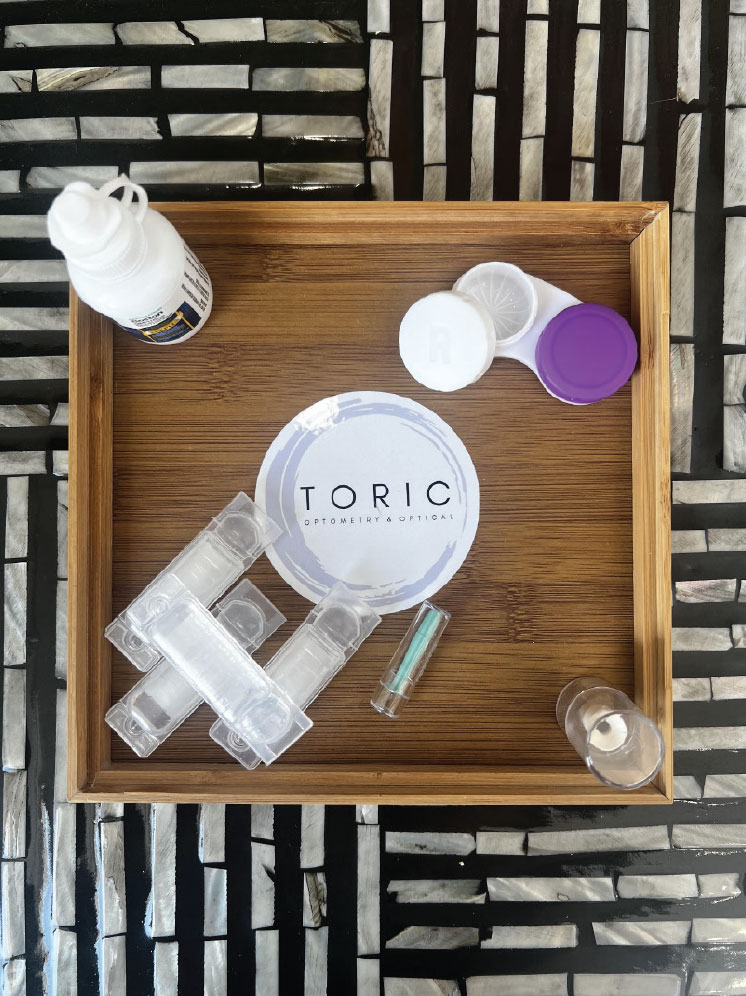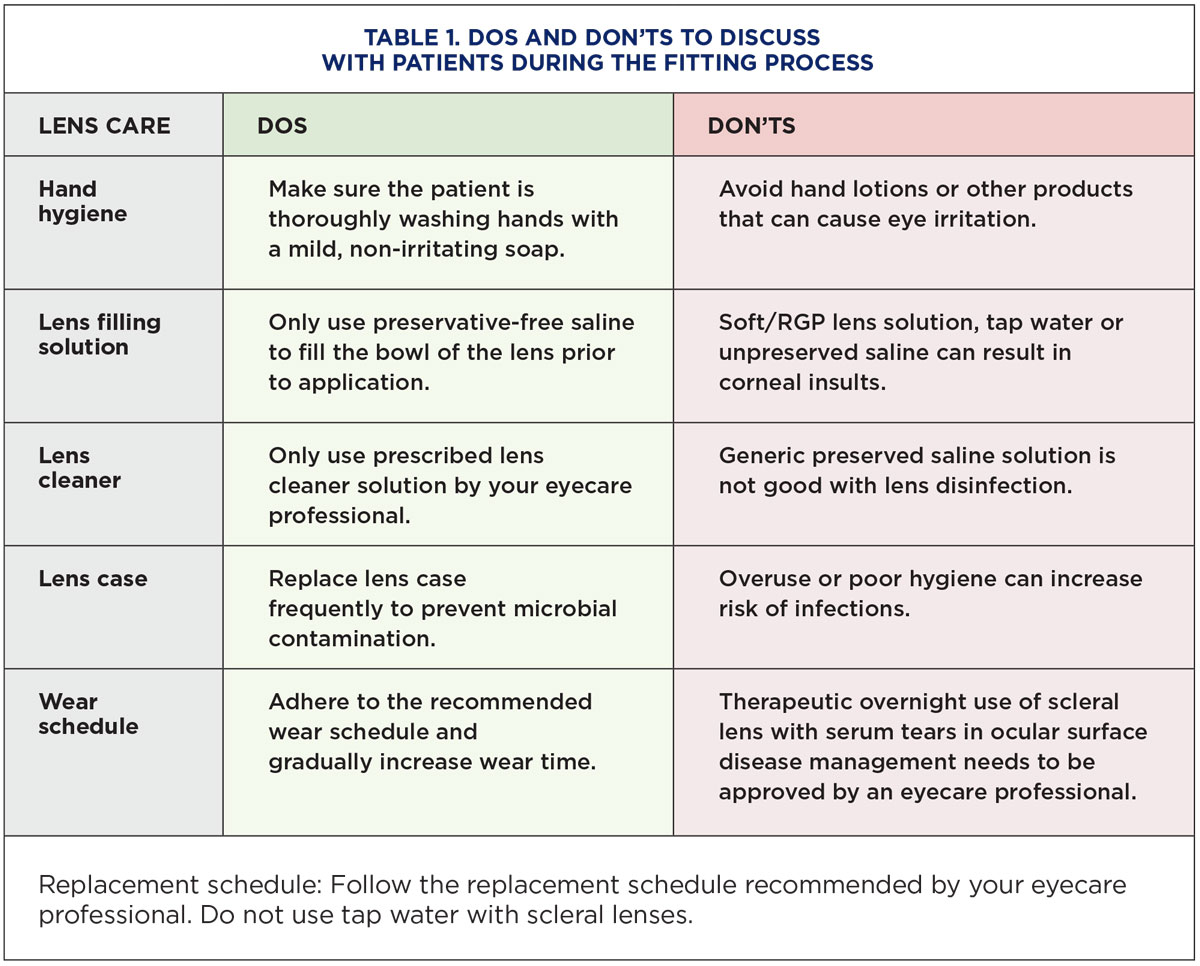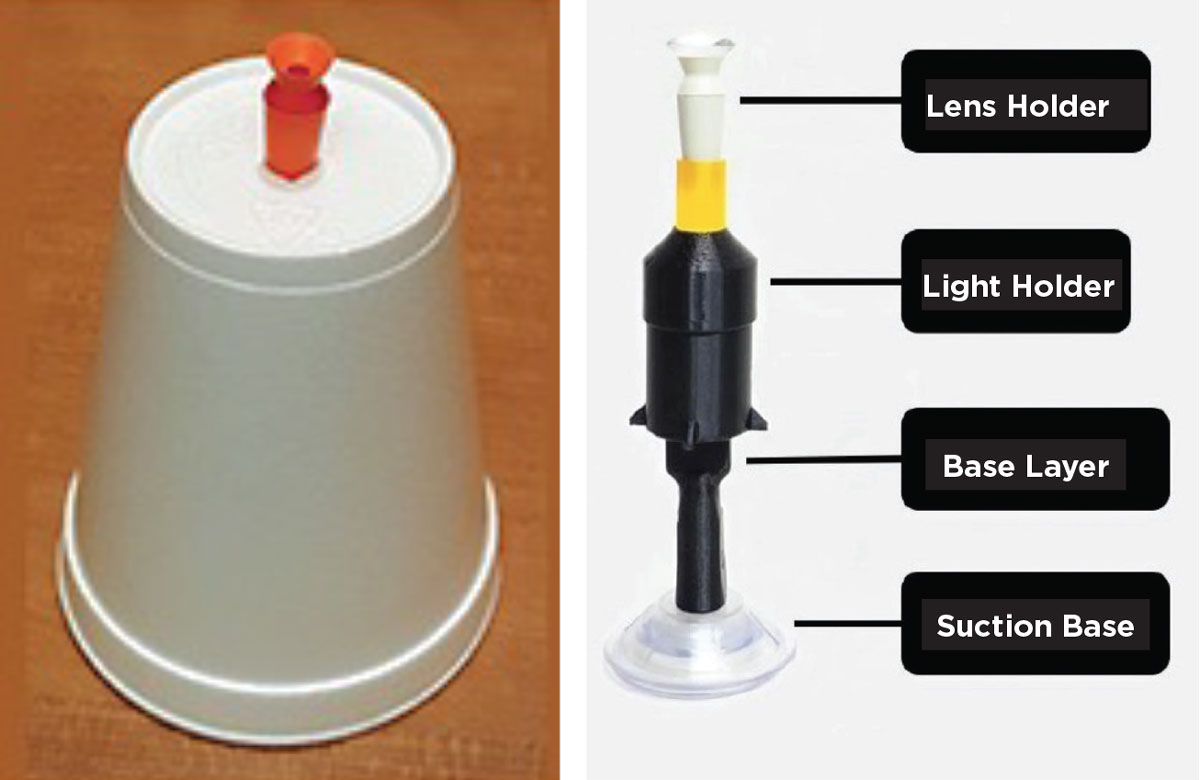The use of scleral lenses has dramatically expanded over the past decade. Their applications have gone beyond visual rehabilitation of corneal irregularities and into the management of ocular surface disease as well as prosthetic devices. As more eyecare professionals continue to expand the scope of scleral lens wear and fit patients with a wide range of ocular pathologies, it is crucial to delve deeper into the importance of having effective communication with patients about scleral lenses. This encompasses teaching patients the dos and don’ts of the care of this lens and providing training on lens application and removal techniques to ensure successful outcomes and reduce rates of dropout. Below are some of my best tips.
Communication and Preparation
 |
|
An easy way to streamline the training process is to gather all needed tools. Photo: Aleena Chaudhary and Manveen Bedi, OD. Click image to enlarge. |
Effective relaying of information is the cornerstone of successful scleral lens wear outcomes in patients. A structured approach to teaching patients, initiated by providing information on scleral lens applicators, products used during the application and removal process, managing insertion bubbles and providing written instructions on lens care hygiene can make the training process more efficient. Start by assessing a patient’s current level of experience with contact lenses. Patients may present with varying levels of experience with handling lenses, so it is important to explore a patient’s comfort level, familiarity with contact lens handling and history of lens wear. This helps establish a baseline to build off of and can help you to tailor their contact lens application and removal training appropriately.
A specialty lens consult is a great opportunity to start preparing the patient for lens handling techniques. Providing graphics and video links to the patient as homework prior to their training session can help them become comfortable with the process of handling the lenses. Asking patients to practice good lid-holding or instilling eye drops are good exercises to perform at home prior to the in-office training. Repetition is key—it is vital to invest time at the beginning so training can run efficiently.
Scleral lens wear can be intimidating for a new contact lens wearer. Using plain language can help ease understanding for patients. Compared with other contact lens training, the process of scleral application and removal is quite rigorous, requiring suction cups and separate solutions for the lens chamber and disinfection. Therefore, it is crucial that before training initiation you familiarize patients with and explain the purpose of the suction tools, preservative-free saline solution and disinfection products involved in the scleral lens wear. Doing so in simple terms can make the process easier to follow and feel less intimidating for a first-time contact lens wearer.
Do’s and Don’ts of Scleral Care
Scleral lens care is complex and involves multiple components: hygiene, lens disinfection, solutions, suction cups and more. It can be difficult for patients to retain all information about these factors during just one clinic visit. Providing written content can ease patients into the process and act as a reliable source to refer to at their own discretion.
 |
| Click image to enlarge. |
Application and Removal Training
The scleral lens training process can definitely be challenging for patients. Here is a step-by-step guide to teach application and removal techniques to patients. Before starting training, ensure that the following products are readily available and the work station has been prepared. Included should be a lens cleaning solution, preservative-free saline, DMV application and removal suction cup, contact lens case, a mirror and tissue paper.
Outlined below are the steps to take for the scleral application process:
1. Start with thorough hand washing with a mild, non-irritating soap and ensure your hands are dry prior to lens handling.
2. Place the mirror flat on the table’s surface where you will be applying the lens. Have tissue on the table to prevent lens scratches in case the lens falls.
3. Place the lens on the application suction cup and fill the bowl of the lens to the brim with preservative-free saline solution.
4. Tilt your head parallel to the ground and look straight into the mirror lying flat on the table.
5. Use one hand to hold both the upper and lower eyelids while maneuvering the suction cup and lens with the other hand closer to the eye.
Tip: Ask the patient to bring the suction cup with the lens upward towards the eye while looking at the hole in the vented suction cup; it provides a good visual target for the patient.
6. Gently release eyelids after the lens is on the eye.
7. Check: After scleral lens application, ensure that there are no bubbles in the lens chamber before proceeding to apply the lens on the other eye. Insertion bubbles are a common issue that can arise when initially learning to apply these lenses and can cause discomfort as well as vision issues. The lens will need to be removed and reapplied if bubbles do form.
Tip: Use the flashlight of your phone to check for bubbles in the mirror for better viewing.
When the patient is ready to continue with removal, this is how the process continues:
1. Start again with thorough hand washing with a mild, non-irritating soap and ensure your hands are dry prior to lens removal.
2. Place the mirror directly in front of you while you are seated.
3. Place your index finger over the lower lid then gently nudge the lower edge of the lens to release suction of the lens. This will introduce bubbles in the lens chamber.
4. Use the DMV removal tool by applying it at the bottom portion of the lens while holding the eyelids with the other hand.
Tip: Do not apply the DMV removal tool on the center of the lens, as this puts more pressure on the cornea during the removal process.
5. Pivot the DMV tool up and out to remove the lens.
6. Remove the lens from the DMV removal tool and place it in the contact lens case filled with fresh lens cleaner solution.
Recommendations and Resources
When dispensing lenses to a first-time scleral lens wearer, the following recommendations can be provided to allow patients to ease into the process. First is to slowly build wear time. Start with four to five hours of lens wear and as the comfort increases, increase the maximum wear time accordingly. Asking patients to wear lenses specifically during your clinic’s hours for the first week is great. This helps in cases where the patient is struggling and may need assistance with lens removal. Other questions they may have about the process can also be answered with a phone call during office hours.
 |
|
A DIY scleral lens stand (left) and S5 Inserter (right). Photos: Brooke Messer, OD, and Thomas Arnold, OD. Click image to enlarge. |
Secondly, provide backups when necessary. The process can be tricky, requiring greater assistance. If a patient is unable to use the hole in the vented DMV cup as a target, whether due to poor vision or struggling with hand tremors, discussing scleral lens stands may be beneficial. There is a way to make your own scleral lens stand, if patients would like to opt for this instead of buying one. To do so, place the DMV application tool at the base of a Styrofoam coffee cup and place an LED light inside the cup. The light will appear through the vented portion of the DMV application tool.
Another backup option is the S5 Inserter. It is a great tool for patients who have back issues or who prefer to stand during lens application. Since the tool can be elongated, it provides the patient greater ease of application while in an upright position. The LED light is an excellent target for patients with poor vision, helping to guide them during the application process.
Takeaways
Scleral contact lenses are a great option for providing visual rehabilitation, management of ocular surface disease and improving patient quality of life. However, proper care and hygiene is critical to ensure eye health safety and optimal results. As eyecare professionals, engaging in effective conversations about the do’s and don’ts of handling scleral lenses and teaching insertion and removal techniques are integral to help patients be successful in their wear.


